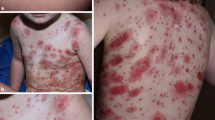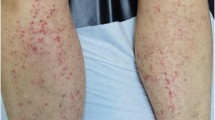Abstract
We report two children with autoinflammatory syndromes treated with anakinra who came in contact with the varicella-zoster virus after being exposed accidentally to infected children: both cases were managed prophylactically with specific antichickenpox intravenous immunoglobulins and anakinra temporary suspension; neither adverse events nor complications related to the natural course of chickenpox were experienced by the two patients. The risk of developing infectious events should be closely monitored, because of the absence of data concerning long-term safety of biological agents in the pediatric age, and prevention strategies should be highly encouraged before they are started.
Similar content being viewed by others
References
Grateau G, Granel B, Hengen V, Dode C, Cuisset L, Delpeche M (2004) Hereditary intermittent fever. Presse Med 33:1195–2206
Arav-Borger R, Spirer Z (1997) Periodic syndromes of childhood. Adv Pediatr 44:389–428
Ozen S (2001) A new insight into periodic and recurrent fever. Clinical aspects and differential diagnosis of periodic fever syndromes. Riv Ital Pediatr 27:616–617
School PR (2000) Periodic fever syndromes. Curr Opin Pediatr 12:563–566
John CC, Gilsdorf JR (2002) Recurrent fever in children. Pediatr Infect Dis 21:1071–1077
Majeed HA (2000) Differential diagnosis of fever of unknown origin in children. Curr Opin Rheumatol 12:439–444
Frenkel J, Kuis W (2002) Overt and occult rheumatic diseases: the child with chronic fever. Best Pract Res Clin Rheumatol 16:443–469
Estlin EJ (2002) Novel targets for therapy in paediatric oncology. Curr Drug Targets Immune Endocr Metabol Disord 2:141–150
Chira P, Sandborg CI (2003) Novel therapies in pediatric rheumatic diseases. Curr Opin Pediatr 15:579–585
Wilkinson N, Jackson G, Gardner-Medwin J (2003) Biological therapies for juvenile arthritis. Arch Dis Child 88:186–191
Dinarello CA, Wolff SM (1993) The role of interleukin-1 in disease. N Engl J Med 328:106–113
Eastgate JA, Symons JA, Wood NC, Grinlinton FM, di Giovine FS, Duff GW (1988) Correlation of plasma interleukin-1 levels with disease activity in rheumatoid arthritis. Lancet 2:706–708
Arend WP, Malyak M, Guthridge CJ, Gabay C (1998) Interleukin-1 receptor antagonist: role in biology. Annu Rev Immunol 16:27–55
Carrasco R, Smith JA, Lovell D (2004) Biologic agents for the treatment of juvenile rheumatoid arthritis: current status. Paediatr Drugs 6:137–146
McDermott MF, Aksentijevich I (2002) The autoinflammatory syndromes. Curr Opin Allergy Clin Immunol 2:511–516
Konttinen L, Kankaanpaa E, Luosujarvi R, Blafield H, Vuori K, Hakala M, Rantalaiho V, Savoilanen E, Uutela T, Nordstrom D, ROB-FIN Study Group (2006) Effectiveness of anakinra in rheumatic disease in patients naïve to biological drugs or previously on TNF blocking drugs: an observational study. Clin Rheumatol 25:882–884
Gartlehner G, Hansen RA, Jonas BL, Thieda P, Lohr KN (2006) The comparative efficacy and safety of biologics for the treatment of rheumatoid arthritis: systematic review and metaanalysis. J Rheumatol 33:2398–2408
Callen JP (2007) Complications and adverse reactions in the use of newer biologic agents. Semin Cutan Med Surg 26:6–14
Ziebold C, von Kries R, Lang R, Weigl J, Schmitt HJ (2001) Severe complications of varicella in previously healthy children in Germany: a 1-year survey. Pediatrics 108:e79
Grimprel E, Levy C, de La Rocque F, Cohen R, Soubeyrand B, Caulin E, Derrough T, Lecuyer A, d’Athis P, Gaudelus J (2007) Paediatric varicella hospitalisation in France: a nationwide survey. Clin Microbiol Infect 13:546–549
Lovell DJ, Giannini EH, Reiff A, Jones OY, Schneider R, Olson JC, Stein LD, Gedalia A, Ilowite NT, Wallace CA, Lange M, Finck BK, Burge DJ, Pediatric Rheumatology Collaborative Study Group (2003) Long-term efficacy and safety of etanercept in children with polyarticular-course juvenile rheumatoid arthritis: interim results from an ongoing multicenter, open-label, extended-treatment trial. Arthritis Rheum 48:218–226
Author information
Authors and Affiliations
Corresponding author
Rights and permissions
About this article
Cite this article
Rigante, D., Ansuini, V., Berrettini, A. et al. Exposition to chickenpox of two children with autoinflammatory syndromes under treatment with anakinra. Rheumatol Int 28, 793–796 (2008). https://doi.org/10.1007/s00296-007-0515-2
Received:
Accepted:
Published:
Issue Date:
DOI: https://doi.org/10.1007/s00296-007-0515-2




